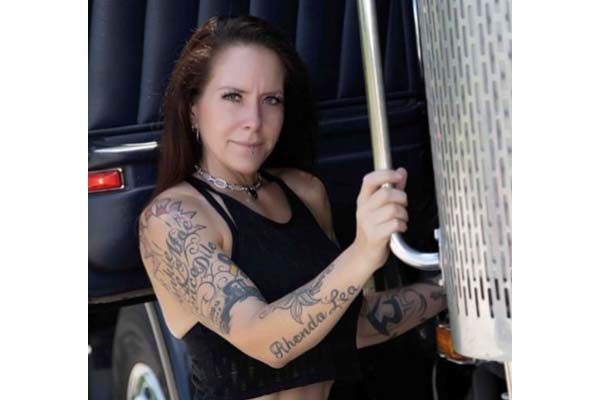Easing on down the road: interview with Melissa Williams
Melissa Williams discovered her passion in an unlikely place: the driver’s seat of her own truck. A big part of the appeal is freedom and independence, she says, but you have to know your limits and stand your ground.

Melissa Williams found her calling the day her company suggested she apply for a commercial driver’s license. Since then, she has made the road her workplace as an independent owner-operator. The freedom she gained driving for herself means that she can choose the routes she wants and visit the places she wants to go. Senior Editor Victoria Kickham recently talked with Williams about life on the road on DC Velocity’s “Logistics Matters” podcast. What follows are some excerpts from their conversation.
Q: We write often about the need for truck drivers across the industry and the many efforts out there to recruit and retain people for the job. You are someone who has gone through that work transition to trucking. How long have you been a driver, and how did you get into the business?
A: I classify myself as a rookie driver. I only have about three and a half years on my license. I was working at FedEx Express at the Minneapolis airport, and a truck driver position opened up. They asked me if I wanted to drive. My immediate response was “You do know I drive a Mini Cooper?”—and they laughed at me. I told them, “Sure, why not? Let’s give it a try.”
How do you know what you love to do if you don’t try everything? Not only that, but if I don’t like it, it just adds to the list of skills that I can draw on in the future.
Q: That makes a lot of sense. Fast forward to today—you are an independent owner-operator and you work over the road, which means you travel long distances and are away from home for long stretches. Can you talk a bit about your job today—how you book loads, how you run your business, and, more broadly, about the advantages of being an independent driver?
A: Sure. I book my loads through the Vorto 5F OTR platform. Basically, I set up what day I want to leave, what city and state [I want to start from], and then I determine how long I want to be out. Do I want to be out a week, two weeks, or whatever? Then I put in where I want to end and on what date.
Let’s say it’s a two-week trip. Basically, they start me out wherever I want to leave from and they bounce me to cities and states that match my preferences—places where I want to go. Then it is always the best-paying option from one place to the next and on to the next. That way it minimizes my amount of deadhead miles and the time I am sitting waiting between loads, so it maximizes my income.
Q: That sounds like a distinct advantage of being your own boss. What else does this allow you to do in terms of the freedom to decide how you do your job?
A: Well, I don’t have to go to any city or state that I don’t want to go to, that I am not comfortable going to. It allows me the opportunity to get out to North Carolina once or twice a month to see my grandfather, who’s 95, or my two younger sons—they’re 18 and 23—who live in Arizona. So I can go where I want to go when I want to go. If I want to stay there for a week and spend time, I can because: A) I am an owner-operator and B) they work with me so that I can have a life while enjoying what it is I do for a living.
Q: When you were working at FedEx a few years ago and decided to enroll in a commercial driver’s license course, did you expect to enjoy the industry as much as it sounds like you do? Has this new career surprised you in any way?
A: Yes. Initially, being a truck driver wasn’t on my radar even though my grandfather was a truck driver. At first, it was local work, and I quickly realized that local work wasn’t for me. I didn’t enjoy it. I figured if I’m going to work long hours in a truck, I want to go places. I want to see things. And that is the luxury of trucking: There are so many different types of work you can do in trucking that you can find what is best for you.
Q: On the flip side of that, what are the main challenges that truckers face today, and are there challenges specific to women drivers?
A: Over-the-road trucking is not for everybody. You have to be comfortable being alone. You have to be comfortable being away from home. It is a very specific lifestyle, and if it’s not for you, then maybe drive local. That is a challenge that a lot of people end up facing.
There are also concerns about safety for women for sure. You are in different cities and different states all the time. As women, we tend to be a little bit more cautious just because, well, we are women.
Q: I understand what you’re saying. Despite all of the challenges you mentioned, it sounds like you would recommend a career in trucking to women and, really, to anyone interested in the freedom that comes with over-the-road driving. What other advice would you give to people interested in pursuing a career in trucking?
A: I think trucking is great for anybody who has a passion or a desire to give it a try because there is so much diversity—flatbed, reefer, local, regional, over-the-road driving. There are a lot of options, but if you’re going to get into trucking, the number one thing that I tell people is know your limits, know your boundaries, and stand by them. Don’t let anyone push you around.
Then if you’re going to go and become an owner-operator, my recommendation is obviously to start as a company driver first to figure out the industry. Figure out what area is going to work best for you, and then learn everything you can about the industry, about the truck that you’re driving or the type of truck that you want to buy, and surround yourself with the kind of people who are doing and being what it is that you want to do and be.
Q: When you say “know your boundaries and don’t let anyone push you around,” do you mean in terms of doing the kind of work you want to do and going where you want to go?
A: Correct. With the ELD [electronic logging device] limitations, there are a lot of times where you may be sitting at a dock for 10 hours waiting to get unloaded. A lot of times as a company driver, your company may tell you “Well, you just had a 10-hour break and now you have to drive.” But just because you were sitting at the dock for 10 hours doesn’t mean that you were sleeping or are rested enough to drive. So, know your physical limitations when it comes to sleep and stress. But also, if you are petrified to go to a particular city, don’t go. Your safety and your mental wellbeing are the most important things.
Q: It’s important that we continue to raise awareness of the trucking profession. What do you think is the most important thing to mention in raising awareness about the importance of the job?
A: Almost everything that you have or use has been on a truck at some point. People are more and more aware of that, but they don’t realize what we go through on a daily basis, a weekly basis, or a monthly basis in order to provide that service to the population.
I also think it’s important that people be aware of the toll long-haul driving can take on a person. Sometimes we haven’t seen our family in a month or two months. A little bit of kindness in society overall goes a long way.
Related Articles

Copyright ©2024. All Rights ReservedDesign, CMS, Hosting & Web Development :: ePublishing